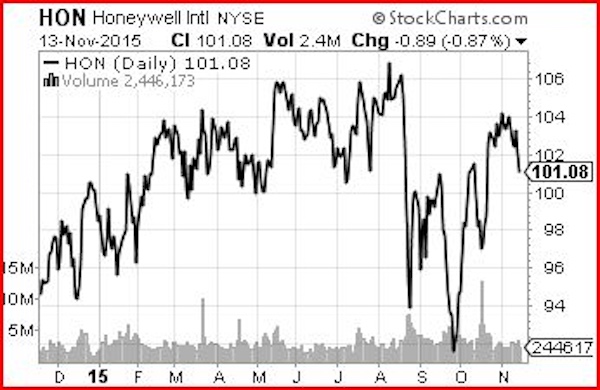Why Honeywell Stock Is Particularly Attractive Now
Ignore the doom and gloom. Keep your eye on stock fundamentals.

It was only two years ago that David Fish, Moneypaper executive editor, observed that "(m)ost of the 'noise' coming out of Wall Street focuses on how high the major indexes have risen and whether the new highs represent a peak." His point? The market pundits were all suggesting that a new bear market might be just around the corner.
Now the “noise” focuses on how the major indexes have fallen this year and the difficulty they have in sustaining each rebound. In other words, a new bear market might be just around the corner, pundits say. The argument is that there are fewer companies with strong earnings growth, which would lead to a collapse in investor confidence just as the Fed begins to raise interest rates.
So it seems that doom lies just around the corner whether stocks are too strong or too weak. Add in weak commodity prices and the plethora of geopolitical unrest, and you have the perfect cocktail of doom and gloom.
From just $107.88 $24.99 for Kiplinger Personal Finance
Become a smarter, better informed investor. Subscribe from just $107.88 $24.99, plus get up to 4 Special Issues

Sign up for Kiplinger’s Free Newsletters
Profit and prosper with the best of expert advice on investing, taxes, retirement, personal finance and more - straight to your e-mail.
Profit and prosper with the best of expert advice - straight to your e-mail.
But let’s step back. If history is any guide, it should be clear that the worries of two years ago ignored the fact that market peaks are generally preceded by a series of new highs, sometimes stretching out over several years.
This year, the volatility and uncertainty ignores the fact that, in the short term, markets are driven as much by emotion as by logic, but strong business operations lead to higher stock prices over the long term.
Our belief now, as it was two years ago, is that investors should focus on the fundamental values of the particular stocks that they own. Strong businesses continue to deliver rising profits (and dividends) year after year, despite the hand-wringing and confusion of traders and pundits, who are in the business of making noise. Don't forget the importance of the “Off” button.
Twice each month, we focus attention on a DRIP stock that appears likely to reward the long-term investor. Our current special is Honeywell International (HON).

Founded in 1920, Honeywell is a global diversified technology and manufacturing company with about $40 billion in annual sales. It operates in four segments: Aerospace (turbine propulsion engines, auxiliary power units, environmental control systems) provides over 30% of sales; Automation and Control Solutions (sensing and security systems for buildings, homes, and industry) over 40%; Transportation (turbochargers, thermal systems, electronic components, and other automotive products) about 10%; and Specialty Materials (resins, chemicals, fibers, films, adhesives) the remainder.
According to Yahoo! Finance, the consensus estimates of 22 analysts call for Honeywell to earn about $6.10 per share this year and $6.56 in 2016, compared with $5.56 in 2014. There are 770.7 million shares outstanding, which is down from 862.3 million in 2003. The dividend has been increased in 10 of the last 11 years, and the most recent increase of 15%, to $2.38 per share annually, provides a 2.3% yield.
What makes Honeywell attractive now is its size and available resources, along with those expectations of higher earnings in the next couple of years. HON has a market capitalization of about $78 billion and an A credit rating, according to Morningstar, which also accords it a wide moat that should deter competitors, a valuable trait during tough economic times, if they should arise. Notably, the newly raised dividend results in a payout ratio of just 39% of earnings, leaving Honeywell with plenty left over for capital expenditures, even in the event of a decline in sales and earnings. Ongoing share repurchases should also enhance per-share results, but can be slowed or suspended if necessary, making the company a "safe haven" during difficult economic conditions.
Honeywell is just one of the high-quality companies that offer investing through a dividend reinvestment plan (DRIP). Honeywell does not charge fees for cash investments or dividend reinvestments through its DRIP. Click here for a list of other no-fee DRIPs.
Ms. Vita Nelson is one of the earliest proponents of dividend reinvestment plans (DRIPs) and a knowledgeable authority on the operations of these plans. She provides financial information centered around DRIP investing at www.drp.com and www.directinvesting.com. She is the Editor and Publisher of Moneypaper's Guide to Direct Investment Plans, Chairman of the Board of Temper of the Times Investor Service, Inc. (a DRIP enrollment service), and co-manager of the MP 63 Fund (DRIPX).
Profit and prosper with the best of Kiplinger's advice on investing, taxes, retirement, personal finance and much more. Delivered daily. Enter your email in the box and click Sign Me Up.

-
 Stocks Chop as the Unemployment Rate Jumps: Stock Market Today
Stocks Chop as the Unemployment Rate Jumps: Stock Market TodayNovember job growth was stronger than expected, but sharp losses in October and a rising unemployment rate are worrying market participants.
-
 Should You Renew Your CD?
Should You Renew Your CD?With rate cuts impacting earnings, we examine if now is a wise time to renew CDs.
-
 7 Ways to Plan Now to Save on Medicare IRMAA Surcharges Later
7 Ways to Plan Now to Save on Medicare IRMAA Surcharges LaterUnderstand the critical two-year lookback period and why aggressive planning before you enroll in Medicare is the most effective way to minimize IRMAA.
-
 Your Year-End Tax and Estate Planning Review Just Got Urgent
Your Year-End Tax and Estate Planning Review Just Got UrgentChanging tax rules and falling interest rates mean financial planning is more important than ever as 2025 ends. There's still time to make these five key moves.
-
 What Makes This Business So Successful? We Find Out From the Founder's Kids
What Makes This Business So Successful? We Find Out From the Founder's KidsThe children of Morgan Clayton share how their father's wisdom, life experience and caring nature have turned their family business into a respected powerhouse.
-
 Past Performance Is Not Indicative of Your Financial Adviser's Expertise
Past Performance Is Not Indicative of Your Financial Adviser's ExpertiseMany people find a financial adviser by searching online or asking for referrals from friends or family. This can actually end up costing you big-time.
-
 I'm a Financial Planner: If You're Not Doing Roth Conversions, You Need to Read This
I'm a Financial Planner: If You're Not Doing Roth Conversions, You Need to Read ThisRoth conversions and other Roth strategies can be complex, but don't dismiss these tax planning tools outright. They could really work for you and your heirs.
-
 Could Traditional Retirement Expectations Be Killing Us? A Retirement Psychologist Makes the Case
Could Traditional Retirement Expectations Be Killing Us? A Retirement Psychologist Makes the CaseA retirement psychologist makes the case: A fulfilling retirement begins with a blueprint for living, rather than simply the accumulation of a large nest egg.
-
 I'm a Financial Adviser: This Is How You Can Adapt to Social Security Uncertainty
I'm a Financial Adviser: This Is How You Can Adapt to Social Security UncertaintyRather than letting the unknowns make you anxious, focus on building a flexible income strategy that can adapt to possible future Social Security changes.
-
 I'm a Financial Planner for Millionaires: Here's How to Give Your Kids Cash Gifts Without Triggering IRS Paperwork
I'm a Financial Planner for Millionaires: Here's How to Give Your Kids Cash Gifts Without Triggering IRS PaperworkMost people can gift large sums without paying tax or filing a return, especially by structuring gifts across two tax years or splitting gifts with a spouse.
-
 'Boomer Candy' Investments Might Seem Sweet, But They Can Have a Sour Aftertaste
'Boomer Candy' Investments Might Seem Sweet, But They Can Have a Sour AftertasteProducts such as index annuities, structured notes and buffered ETFs might seem appealing, but sometimes they can rob you of flexibility and trap your capital.